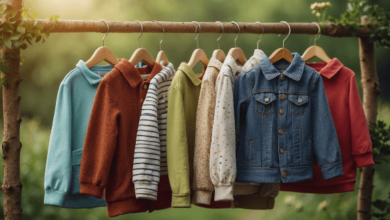The Ultimate Guide to Sustainable Fashion: Trends for 2024

Sustainable fashion has become more than a buzzword; it’s a movement reshaping the global fashion industry. As environmental awareness grows, more consumers are demanding eco-friendly options from their favorite brands. Fashion, notorious for its massive ecological footprint, is undergoing a transformation, and 2024 promises to be a pivotal year for this shift. In this guide, we’ll dive deep into the trends driving sustainable fashion in 2024, exploring how the industry is embracing ethical practices and the innovative solutions being pioneered to minimize harm to the environment.
Understanding Sustainable Fashion
Sustainable fashion refers to clothing, accessories, and footwear that are produced in a way that minimizes their environmental impact. This includes using eco-friendly materials, reducing carbon emissions during production, promoting fair labor practices, and designing items for longevity rather than disposability. The concept extends beyond “greenwashing” (when brands falsely promote sustainability) and requires a commitment to ethical manufacturing, responsible sourcing, and a circular economy.
Why Sustainable Fashion Matters More Than Ever
In 2024, the urgency surrounding climate change, resource depletion, and social inequality makes sustainable fashion essential. The fashion industry is responsible for around 10% of global carbon emissions, vast amounts of water waste, and pollution through harmful dyes and synthetic materials. Moreover, the rise of fast fashion has led to a culture of overconsumption, where cheap, low-quality garments are worn only a few times before being discarded.
Addressing these challenges means rethinking how clothing is made, used, and disposed of. Sustainable fashion offers a solution by encouraging environmentally friendly choices and reducing the industry’s overall carbon footprint. But what trends will shape the future of this movement?
Trend 1: Circular Fashion Economy
In 2024, the fashion industry will increasingly adopt the principles of a circular economy. This trend involves designing products with their entire lifecycle in mind— from creation to disposal. Instead of a linear model, where clothes are made, worn, and discarded, the circular fashion economy focuses on reusing, recycling, and regenerating materials.
Brands are investing in “take-back” programs, where they encourage customers to return old clothing for recycling or repurposing. Many are exploring innovative ways to make garments out of recycled fabrics, drastically reducing the need for virgin materials. The result? A looped system where waste is minimized, and resources are reused.
Trend 2: The Rise of Eco-Friendly Materials
The shift from traditional, environmentally damaging materials to sustainable alternatives is set to dominate the fashion landscape in 2024. Organic cotton, Tencel, hemp, bamboo, and other plant-based fibers are becoming mainstream. These materials are grown without harmful pesticides and fertilizers, require less water, and produce lower carbon emissions.
Moreover, innovations in fabric technology have led to the creation of bio-based and biodegradable textiles. These new materials not only reduce the impact of production but also break down naturally after the end of their useful life. Brands are also tapping into recycled materials, including ocean plastic, discarded fishing nets, and post-consumer waste, to create high-quality, eco-friendly clothing.
Trend 3: Slow Fashion Movement
As a direct response to the fast fashion craze, slow fashion emphasizes quality over quantity. Consumers in 2024 are expected to prioritize garments made to last— those crafted with superior fabrics and techniques. Slow fashion encourages shoppers to think about the longevity of their clothing, investing in pieces that will stand the test of time rather than chasing fleeting trends.
By purchasing fewer, higher-quality items, consumers are reducing the demand for mass-produced, cheaply made garments. This shift has significant environmental benefits, as it leads to less waste, fewer emissions, and a reduction in the depletion of natural resources.
Trend 4: Ethical Fashion and Fair Trade
Sustainability isn’t just about the environment; it’s also about treating workers fairly. Ethical fashion focuses on improving labor conditions and ensuring that garment workers receive fair wages and work in safe environments. In 2024, we will see a continued emphasis on transparency in supply chains, with brands disclosing the sources of their materials and the treatment of their workers.
Fair Trade certification is gaining traction, as consumers seek to support brands that uphold human rights. This trend is empowering workers in developing countries and ensuring that fashion production doesn’t come at the cost of exploitation or unsafe working conditions.
Trend 5: Rent, Resale, and Subscription Models
One of the most exciting shifts in sustainable fashion for 2024 is the rise of clothing rental, resale, and subscription services. These models allow consumers to access a wide variety of styles without the environmental impact of producing new clothing.
Rental services, in particular, are popular among those seeking high-end fashion without committing to a purchase. Instead of buying a garment they might only wear once, shoppers can rent designer items for special occasions. Similarly, resale platforms offer a second life to gently used clothing, keeping items out of landfills while making sustainable fashion more accessible.
Subscription boxes, where consumers receive a curated selection of clothes monthly, are another growing trend. These services offer a personalized shopping experience with a focus on sustainability, sending out pieces that align with both style preferences and eco-conscious values.
Trend 6: Vegan and Cruelty-Free Fashion
The demand for vegan and cruelty-free fashion is set to skyrocket in 2024. Shoppers are increasingly looking for alternatives to leather, fur, and wool, opting instead for plant-based or synthetic options that are kinder to animals and the environment.
Vegan leather made from materials like apple peels, mushrooms, and pineapple leaves is becoming more common, offering a cruelty-free alternative to traditional leather. Likewise, cruelty-free brands are gaining popularity for their commitment to producing fashion without animal testing or harm. This trend aligns with a broader movement toward more ethical consumption across all industries.
Trend 7: Technological Innovations in Fashion
Technology is playing a crucial role in making fashion more sustainable in 2024. From 3D printing to AI-driven design, innovations are helping brands reduce waste and create garments more efficiently.
For example, 3D knitting technology allows designers to create clothing with zero waste. The exact amount of fabric needed for a garment is used, eliminating the excess material that would otherwise end up in landfills. AI is also helping brands predict fashion trends more accurately, reducing the need for overproduction.
Furthermore, blockchain technology is being used to enhance transparency in supply chains. With blockchain, consumers can track the entire journey of a garment, from raw materials to the finished product, ensuring ethical practices are followed at every stage.
Trend 8: Local and Small-Scale Production
2024 will see a resurgence in support for local artisans and small-scale producers. This trend emphasizes the importance of reducing the carbon footprint associated with long-distance shipping and supporting local economies. Many brands are opting for smaller, localized production facilities, which allow for more oversight and control over ethical and environmental standards.
By choosing to buy locally made clothing, consumers are directly supporting sustainable practices. Additionally, this approach fosters a greater connection between shoppers and the people who make their clothes, reinforcing the idea that fashion should be about quality, not quantity.
Trend 9: Gender-Neutral and Inclusive Fashion
Sustainability in fashion also extends to inclusivity. In 2024, more brands are moving toward gender-neutral and size-inclusive designs, recognizing that sustainable fashion should be accessible to everyone, regardless of gender identity, size, or shape. This inclusive approach not only broadens the customer base but also promotes a more thoughtful approach to design, where every piece is made to fit a diverse range of bodies.
Trend 10: Conscious Consumerism and Education
Ultimately, the success of sustainable fashion in 2024 will depend on conscious consumerism. Consumers are becoming more educated about the environmental and social impacts of their purchasing decisions, and this awareness is driving change in the industry. Brands are increasingly focusing on educating their customers, offering transparency about their practices, and encouraging mindful shopping habits.
As more consumers adopt sustainable values, they are voting with their wallets, supporting brands that align with their ethics. This shift in consumer behavior is pushing the fashion industry to prioritize sustainability and innovate in ways that minimize harm to the planet.
Conclusion
The trends shaping sustainable fashion in 2024 are a testament to the industry’s commitment to a more responsible future. From embracing the circular economy and eco-friendly materials to championing ethical labor practices and technological innovations, fashion is evolving to meet the demands of a more environmentally conscious world. As we move forward, it’s clear that sustainability is no longer a niche movement—it’s becoming the standard for how fashion is designed, produced, and consumed.





